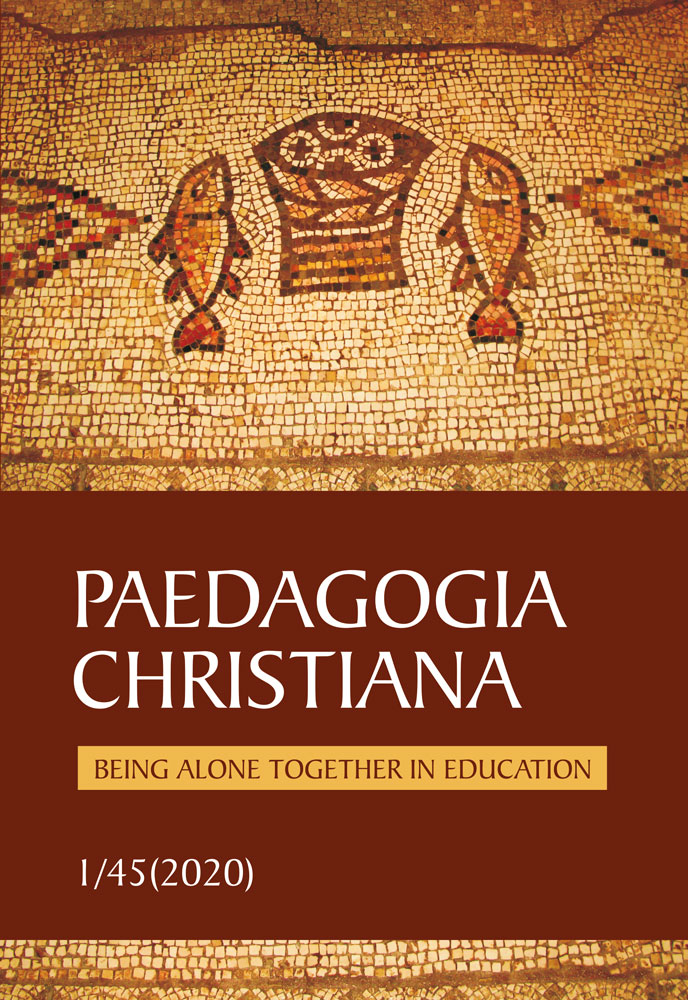Figures on a Windswept Shore: The Interplay of Aloneness and Communitas in Oral Storytelling
DOI:
https://doi.org/10.12775/PCh.2020.008Słowa kluczowe
opowiadanie historii, samotność, wspólnota, wewnętrzność, młodzi ludzie, opowiadanie historii a zdrowie psychiczneAbstrakt
Postaci na wichrowym brzegu. Współzależność samotności i wspólnotowości w ustnym opowiadaniu historii
Opowiadanie historii jest artystyczną praktyką, rozumianą często jako tworzenie poczucia bycia razem, lub, używając bardziej dokładnego terminu autorstwa Victora Turnera (1969), ‘communitas’ – wspólnoty. Jednak moje doświadczenie jako gawędziarza (storyteller) w pracy z młodymi ludźmi w wielu kontekstach, w tym klinik zdrowia psychicznego, ukazuje samotność jako równie istotną cechę spotkań mających na celu opowiadanie historii. Wiele opowieści przedstawia osamotnione postacie i opowiadanie o nich przywołuje własne doświadczenie osamotnienia snującego narrację. Wielu słuchaczy ceni możliwość pozostawienia ich samych na czas trwania historii i zareagowania na nią prywatnie. Obserwowanie tego nasuwało mi często alegorię opowieści jako skalistego brzegu, na którym każdy ze słuchaczy wędruje osobno, pozostając świadomym obecności innych. W niniejszym eseju „przeplatam” historię pt. „Skradzione Dziecko”, baśń o wyizolowanej młodej kobiecie, ze spostrzeżeniami z dwóch klinik zdrowia psychicznego dla młodzieży, w których prowadziłam warsztaty z opowiadania historii (storytelling). W ten sposób staram się zilustrować współzależność samotności i wspólnotowości w ustnym przekazywaniu historii, na którą zwrócił uwagę Jean-Luc Nancy (1991, s. 35), pisząc, iż „pojedyncze byty wspierają się razem”. Tak więc nie sposób mówić o prostym przeciwstawieniu sobie samotności i wspólnotowości; oferuję nieśmiało eksperymentalny dowód, iż momenty zaskakującego połączenia umożliwia uprzednie pozwolenie, by być oddzielonym.
Bibliografia
Benjamin, W. (1973 [1936]). The Storyteller: Reflections on the Works of Nikolai Leskov. In H. Arendt (ed.), Illuminations (pp. 83-109). London: Fontana.
Gaylord, K. (1983). Theatrical performances: Structure and process, tradition and revolt. In J. B. Kamerman & R. Martorella (eds.), Performers & Performances: The social organization of work (pp. 13-49). New York: Praeger Publishers.
Gersie, A. (1997). Reflections on Therapeutic Storymaking: the use of stories in groups. London and Bristol, Pennsylvania: Jessica Kingsley Publishers.
Heinemeyer, C. (2015). Storytelling at an adolescent mental health unit. Storytelling with Adolescents – research through practice. http://storytellingwithadolescents.blogspot.com/2015/03/storytelling-at-adolescent-mental.html [accessed 10.02.2020].
Heinemeyer, C. (2018). Adventures in storyhacking: facilitating indirect inter-community dialogue through storytelling. Teaching Artist Journal, 16, 3-4. DOI: 10.13140/RG.2.2.11861.27361.
Kuppers, P. (2007). Community Arts Practices: Improvising being-together. In P. Kuppers & G. Robinson, G. (eds.), The Community Performance Reader (pp. 34-47). Abingdon: Routledge.
Levinas, E. (1969). Totality and Infinity: an essay on exteriority. Tr. A. Lingis. Pittsburgh: Duquesne University Press.
Mead, G. (2011) Coming Home To Story: Storytelling beyond happily ever after. Bristol: Vala Publishing.
Nancy, J.-L. (1991). Inoperative Community. Trans. P. Connor, L. Garbus, M. Holland, & S. Sawhney. Minneapolis, MI: University of Minnesota Press.
Ryan, P. & Schatt, D. (2014). Can You Describe the Experience? Storytelling, Self, Society, 10(2), 131-155.
Stallings, F. (1988). The web of silence: The storyteller’s power to hypnotize. National Storytelling Journal, 5(2), 4-13.
Stern, J. (2015). Soul-searching and re-searching: action philosophy alone. Educational Action Research, 23(1), 104-115. DOI: 10.1080/09650792.2014.994015.
Turner, V. (1969). Liminality and Communitas. In V. Turner (ed.), The Ritual Process: Structure and Anti-Structure (pp. 94-130). Chicago: Aldine Publishing.
Van Deusen, K. (2001). The Flying Tiger: Women Shamans and Storytellers of the Amur. McGill-Queen’s University Press.
Vygotsky, L. S. (1967). Imagination and Creativity in Childhood. Journal of Russian and East European Psychology, 42(1), 7-97.
Pobrania
Opublikowane
Jak cytować
Numer
Dział
Licencja
Prawa autorskie (c) 2020 Paedagogia Christiana

Utwór dostępny jest na licencji Creative Commons Uznanie autorstwa – Bez utworów zależnych 4.0 Międzynarodowe.
Statystyki
Liczba wyświetleń i pobrań: 662
Liczba cytowań: 0



